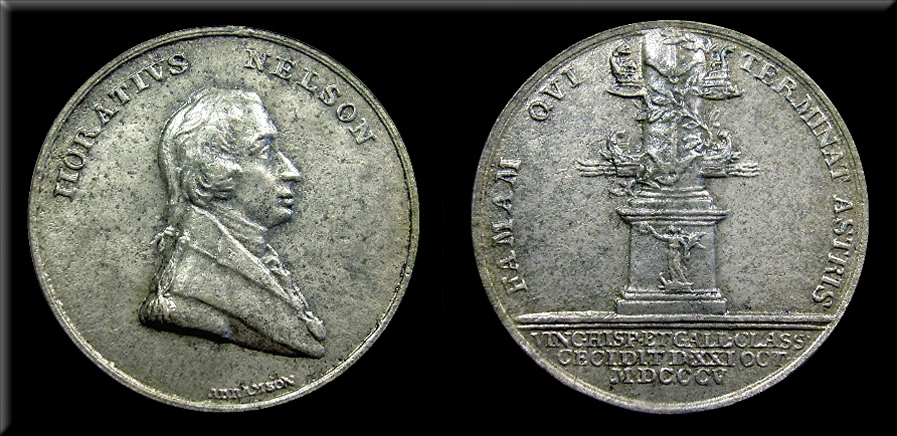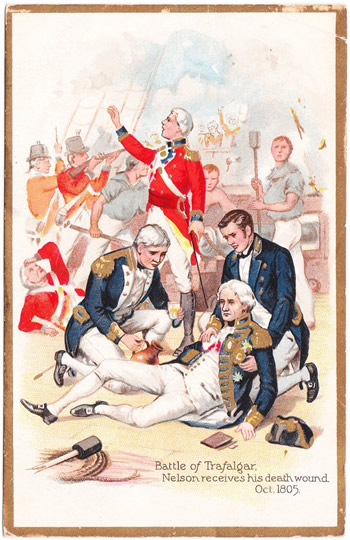Death of Nelson and battle of Trafalgar - 1805

Side 1: HORATIVS NELSON |
Side 2: FAMAM QUI TERMINAT ASTRIS |
Bramsen 438, BHM 574, d'Essling 1087 |
Mm. 39 - White metal - RR |
Engraver: Abramson |
|
BRAMSEN 438 - (Abramson) Combat Naval de Trafalgar, mort de Nelson - (Description) |
|
HORATIVS NELSON. Buste en uniforme, à droite. |
Rev: FAMAM QUI TERMINAT ASTRIS. Une colonne rostrale. Exergue: VINC. HISP. ET GALL. CLASS. CECIDIT D. XXI OCT. MDCCCV. |
Médaille, 40 mm. - T.N. 9, 4 C. |
|
British Historical Medals - 574 - DEATH OF LORD NELSON |
|
AR, WM 40 by A. Abramson |
|
Obv. Uniformed bust of Lord Nelson right, hair in pigtail. HORATIVS NELSON |
Rev. A rostral column decorated with anchors, four prows of galleys and laurel wreaths. Victory standing on prow on base of column. FAMAM QUI TERMINAT ASTRIS (Who bounds his fame only by the stars). In exergue: VINC. HISP. ET GALL. CLASS. CECIDIT D. XXI OCT. MDCCCV (In conquering the Spanish and French fleets, he fell 21 October, 1805). |
AR RR; WM RR. MH. 497; S. FF/18 BM. |
|
...Horatio Nelson (1758-1805), Viscount, Duke of Bronte, the third surviving son of the Reverend Edmund Nelson, born at Burnham Thorpe rectory in Norfolk. He entered the Navy as a midshipman under his uncle Captain Maurice Suckling of the Raisonnable. In 1773 Nelson accompanied a North Pole expedition for scientific research under the Hon. Daines Barrington and two years later joined the frigate Seahorse. It was on this voyage to the East Indies that he contracted a fever which recurred throughout his life. A distinguished career in the navy cost him his right eye at the reduction of Bastia and Calvi and the loss of his right arm in an attack upon a Spanish ship at Santa Cruz. Nelson's final battle came at Cape Trafalgar where he exposed himself to severe musketry fire. At about 1,30 p.m. he was hit in the left shoulder by a musket ball fired by a sharp-shooter in the Redoubtable. The ball passed through the spine and lodged in the muscles of the back. Nelson lived long enough to know the result of the engagement and died in the arms of Captain Hardy saying 'I have done my duty, praise God for it'. The ball that killed him is preserved in the Waterloo Room at Windsor Castle. ...The medal described here is by a foreign artist, Abraham Abramson, the son of Jacob Abramson; he spent his life working in Germany and his medal of Nelson was probably struck here. The portrait of Nelson is somewhat unusual and the medal is included here for the sake of completeness. |
|
